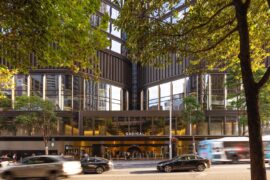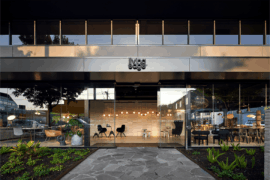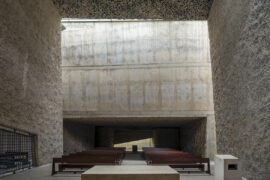Anne Warr finds uniting themes at Shanghai Expo 2010.
April 26th, 2010
WORDS ANNE WARR
Sustainability has been used as a design generator for a number of the national pavilions.
The Spanish Pavilion by the Barcelonese studio Miralles Tagliabue (EMBT) is clad in more than 8,000 wicker panels handmade by craftsmen in Shandong Province.
The wickerwork cladding unites China and Spain through a shared craft tradition, while displaying the possibilities of a low-tech renewable resource.
The Finnish Pavilion is surfaced in scale-like shingles, a new construction material made of recycled paper and plastic, while a newly developed translucent concrete envelopes the Italian pavilion by architect Giampaolo Imbrighi.
Many national pavilions have struggled to find ways to adequately represent their brand in such a small space. Others have opted to focus on a single idea as a way of expanding our thinking about a time and place.
The United Kingdom pavilion, by Thomas Heatherwick, explores the relationship between nature and the city.
The six storey high pavilion is formed with 60,000 slender transparent rods which focus natural light onto a single seed at the end of each rod. The seeds are from the Millennium Seedbank, a project run by the Royal Botanical Society at Kew Gardens to research, store and catalog a seed from every plant existing in the world.
The UK pavilion has four other display areas, each one drawing on the theme of nature and the city.
Shanghai Expo 2010
en.expo2010.cn
INDESIGN is on instagram
Follow @indesignlive
A searchable and comprehensive guide for specifying leading products and their suppliers
Keep up to date with the latest and greatest from our industry BFF's!

London-based design duo Raw Edges have joined forces with Established & Sons and Tongue & Groove to introduce Wall to Wall – a hand-stained, “living collection” that transforms parquet flooring into a canvas of colour, pattern, and possibility.

Rising above the new Sydney Metro Gadigal Station on Pitt Street, Investa’s Parkline Place is redefining the office property aesthetic.

Welcomed to the Australian design scene in 2024, Kokuyo is set to redefine collaboration, bringing its unique blend of colour and function to individuals and corporations, designed to be used Any Way!

For Aidan Mawhinney, the secret ingredient to Living Edge’s success “comes down to people, product and place.” As the brand celebrates a significant 25-year milestone, it’s that commitment to authentic, sustainable design – and the people behind it all – that continues to anchor its legacy.
Miele Australia introduces the Miele DA 5000 D Island Rangehood, a truly innovative and highly functional kitchen appliance.
This relaxing armchair designed by EOOS for Walter Knoll invites you to read, watch TV, listen to music or quite simply daydream. At the push of a button, you can change the angle of the chair back, anywhere from upright to reclined; the headrest is adjustable and the chair rotates, with the perfect upholstered seat. […]
The internet never sleeps! Here's the stuff you might have missed

The World Architecture Festival has named The Holy Redeemer Church and Community Centre of Las Chumberas in La Laguna, Spain as World Building of the Year 2025, alongside major winners in interiors, future projects and landscape.

A lighter, roomier feel in your space can start at your window.